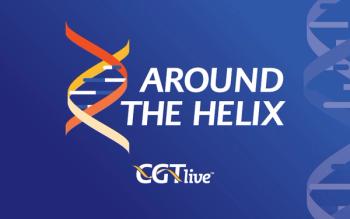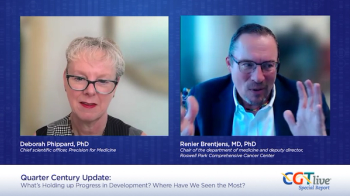
Gemcitabine Matches Efficacy of Cisplatin-Etoposide in Advanced NSCLC
VIENNA--Although the majority of patients with advanced non-small-cell lung cancer (NSCLC) are too ill to tolerate platinum therapy, the more benign safety profile of gemcitabine (Gemzar) is opening up the possibility of palliative chemotherapy for a wider group of NSCLC patients.
VIENNA--Although the majority of patients with advanced non-small-celllung cancer (NSCLC) are too ill to tolerate platinum therapy, the morebenign safety profile of gemcitabine (Gemzar) is opening up the possibilityof palliative chemotherapy for a wider group of NSCLC patients.
"Gemcitabine is at least as effective as and much less toxic thanthe standard two-drug combination chemotherapy of cisplatin [Platinol]and etoposide," said Dr. Christian Manegold in his report of the resultsof a European multicenter trial at the 21st Congress of the European Societyfor Medical Oncology (ESMO).
This phase II study randomized patients with stage III or IV NSCLC toreceive either gemcita-bine (1,000 mg/m2 as a 30-minute IV infusionon days 1, 8, and 15 of a 28-day cycle) or cisplatin (100 mg/m2 onday 1) plus etoposide (100 mg/m2 on days 1, 2, and 3 of a 28-daycycle). None of the 150 participants had undergone prior chemotherapy orprevious irradiation of the measured lesion, and none had CNS metastases.
The two regimens yielded entirely comparable response rates (18% withgemcitabine and 15% with cisplatin-etoposide), times to progression (4.2months and 4.9 months, respectively), and median survival durations (6.6months and 7.6 months, respectively).
No Serious Hematologic Toxicity
Neither chemotherapy regimen was seriously compromised by hematologictoxicity, with roughly three quarters of patients in both arms maintainingnormal neutrophil counts.
Nausea and vomiting were common in the cisplatin-etoposide group, reachingsevere proportions in more than a quarter of patients. Nearly half of thegemcitabine-treated patients were free of nausea and vomiting.
An especially striking contrast, Dr. Manegold emphasized, was in theincidence of alopecia, which afflicted more than 80% of patients in thecombination arm but only 3% of gemcitabine-treated patients.
Newsletter
Stay at the forefront of cutting-edge science with CGT—your direct line to expert insights, breakthrough data, and real-time coverage of the latest advancements in cell and gene therapy.










































